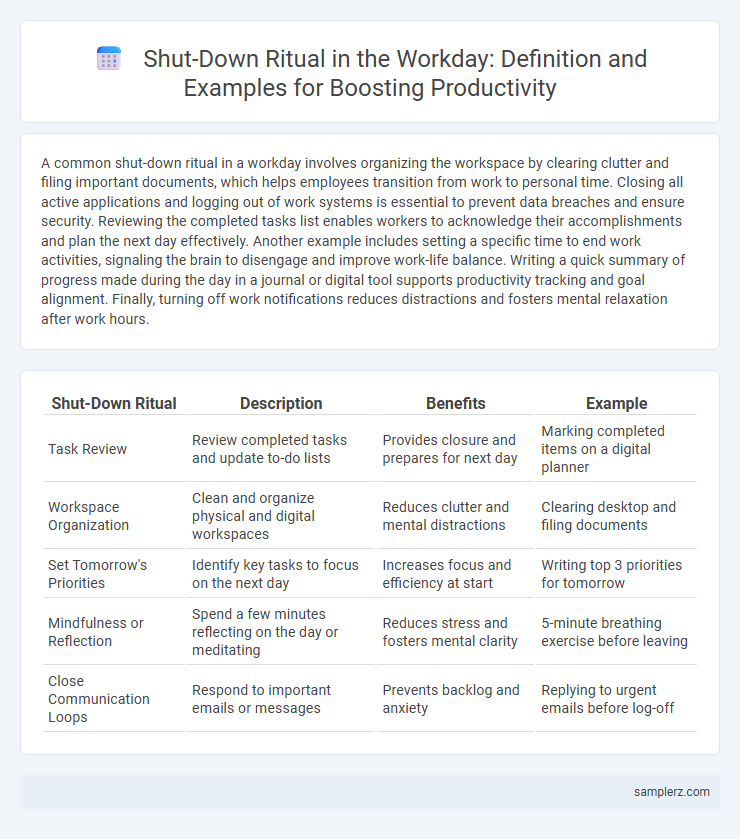A common shut-down ritual in a workday involves organizing the workspace by clearing clutter and filing important documents, which helps employees transition from work to personal time. Closing all active applications and logging out of work systems is essential to prevent data breaches and ensure security. Reviewing the completed tasks list enables workers to acknowledge their accomplishments and plan the next day effectively. Another example includes setting a specific time to end work activities, signaling the brain to disengage and improve work-life balance. Writing a quick summary of progress made during the day in a journal or digital tool supports productivity tracking and goal alignment. Finally, turning off work notifications reduces distractions and fosters mental relaxation after work hours.
Table of Comparison
| Shut-Down Ritual | Description | Benefits | Example |
|---|---|---|---|
| Task Review | Review completed tasks and update to-do lists | Provides closure and prepares for next day | Marking completed items on a digital planner |
| Workspace Organization | Clean and organize physical and digital workspaces | Reduces clutter and mental distractions | Clearing desktop and filing documents |
| Set Tomorrow's Priorities | Identify key tasks to focus on the next day | Increases focus and efficiency at start | Writing top 3 priorities for tomorrow |
| Mindfulness or Reflection | Spend a few minutes reflecting on the day or meditating | Reduces stress and fosters mental clarity | 5-minute breathing exercise before leaving |
| Close Communication Loops | Respond to important emails or messages | Prevents backlog and anxiety | Replying to urgent emails before log-off |
What Is a Workday Shut-Down Ritual?
A workday shut-down ritual is a structured routine employees follow at the end of their work hours to signal the transition from work to personal time, enhancing productivity and work-life balance. This typically includes activities like reviewing completed tasks, planning priorities for the next day, and organizing the workspace to reduce stress and improve focus. Implementing a consistent shut-down ritual helps prevent burnout, promotes mental clarity, and reinforces a healthy boundary between professional duties and personal life.
Benefits of Implementing Shut-Down Rituals
Implementing shut-down rituals at the end of the workday enhances mental clarity by signaling the brain to transition from work mode to personal time, reducing stress and preventing burnout. These rituals, such as organizing tasks for the next day or a brief mindfulness practice, improve overall productivity by fostering a sense of closure and accomplishment. Consistent shut-down routines support better work-life balance and increase focus during working hours by eliminating lingering work-related thoughts.
Simple Steps for an Effective Shut-Down Routine
Ending the workday with a simple shut-down ritual enhances productivity by creating clear boundaries between work and personal time. Key steps include reviewing completed tasks, updating the to-do list for the next day, and tidying the workspace to promote mental clarity. Implementing these straightforward actions consistently fosters focus, reduces stress, and improves overall work-life balance.
Example 1: Creating Tomorrow’s To-Do List
Creating tomorrow's to-do list serves as an effective shut-down ritual by organizing pending tasks and setting clear priorities for the next workday. This practice enhances focus, reduces mental clutter, and increases productivity by allowing employees to start the day with a structured plan. Incorporating task categorization and estimated time allocation further optimizes workflow and improves time management.
Example 2: Email Inbox Zero
Implementing an Email Inbox Zero shut-down ritual enhances productivity by reducing cognitive load and preventing task spillover after work hours. This practice involves systematically processing all emails--responding, delegating, or deleting--to maintain an empty inbox before ending the workday. Consistently achieving inbox zero promotes mental clarity, minimizes email-related stress, and improves focus for the following day.
Example 3: Desk Organization Practices
Implementing desk organization practices as a shut-down ritual enhances workplace productivity by reducing clutter and minimizing distractions. Consistently sorting papers, filing documents, and cleaning the workspace at the end of each workday creates an environment conducive to focus and efficiency. This routine supports mental clarity and prepares individuals for a fresh start the following day, promoting sustained productivity.
Example 4: Reflecting on Daily Achievements
Reflecting on daily achievements involves reviewing completed tasks and assessing progress toward goals, which reinforces a sense of accomplishment and highlights areas for improvement. This shut-down ritual enhances productivity by fostering self-awareness and promoting continuous growth. Incorporating a brief journaling session or digital recap can solidify insights and prepare the mind for the next workday.
Example 5: Setting Work-Life Boundaries
Setting clear work-life boundaries by implementing a shutdown ritual enhances productivity and mental well-being. Concluding the workday with a specific routine, such as turning off work devices and planning the next day, signals the brain to transition into personal time. This practice reduces burnout and improves focus during working hours by establishing a definitive end to work-related responsibilities.
Digital Device Shut-Down Techniques
Digital device shut-down techniques enhance productivity by minimizing distractions and signaling the end of the workday. Methods such as closing all work-related applications, logging out of communication platforms, and powering down devices create clear boundaries between work and personal time. Implementing these rituals reduces digital fatigue and improves focus for the following day.
Tips for Building Your Personalized Shut-Down Ritual
Creating a personalized shut-down ritual enhances productivity by signaling the end of the workday and promoting mental clarity. Effective tips include setting a specific time to review completed tasks, organizing your workspace for the next day, and practicing a brief mindfulness exercise to transition from work mode to relaxation. Consistency in these habits supports work-life balance and reduces stress, improving overall efficiency.

example of shut-down-ritual in workday Infographic
 samplerz.com
samplerz.com